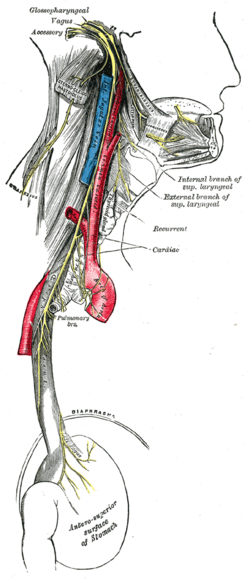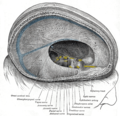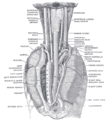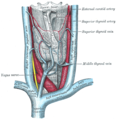Vagus nerve
| Vagus nerve | |
|---|---|
 | |
 | |
| Details | |
| Innervates | Levator veli palatini, Salpingopharyngeus, Palatoglossus, Palatopharyngeus, Superior pharyngeal constrictor, Middle pharyngeal constrictor, Inferior pharyngeal constrictor, viscera |
| Identifiers | |
| Latin | nervus vagus |
| MeSH | D014630 |
| NeuroNames | 702 |
| TA98 | A14.2.01.153 |
| TA2 | 6332 |
| FMA | 5731 |
| Anatomical terms of neuroanatomy | |
| Cranial nerves |
|---|
|
The vagus nerve (/[invalid input: 'icon']ˈveɪɡəs/ Template:USdict), also called pneumogastric nerve or cranial nerve X, is the tenth of twelve (excluding CN0) paired cranial nerves. Upon leaving the medulla between the medullary pyramid and the inferior cerebellar peduncle, it extends through the jugular foramen, then passing into the carotid sheath between the internal carotid artery and the internal jugular vein down below the head, to the neck, chest and abdomen, where it contributes to the innervation of the viscera. Besides output to the various organs in the body, the vagus nerve conveys sensory information about the state of the body's organs to the central nervous system. 80-90% of the nerve fibers in the vagus nerve are afferent (sensory) nerves communicating the state of the viscera to the brain.[1]
The medieval Latin word vagus means literally "wandering" (the words vagrant, vagabond, and vague come from the same root). Sometimes the branches are spoken of in the plural and are thus called vagi (/ˈveɪdʒaɪ/, Template:USdict). The vagus is also called the pneumogastric nerve since it innervates both the lungs and the stomach.
The motor division of the vagus nerve is derived from the basal plate of the embryonic medulla oblongata, while the sensory division originates from the cranial neural crest.
The vagus nerve includes axons which emerge from or converge onto three nuclei of the medulla:
- The Dorsal nucleus of vagus nerve - which sends parasympathetic output to the viscera esp intestines
- The Nucleus ambiguus - which sends parasympathetic output to the heart (slowing it down) and
- The Solitary nucleus - which receives afferent taste information and primary afferents from visceral organs
Branches
- Auricular nerve
- Pharyngeal nerve
- Superior laryngeal nerve
- Superior cervical cardiac branches of vagus nerve
- Inferior cervical cardiac branch
- Recurrent laryngeal nerve
- Thoracic cardiac branches
- Branches to the pulmonary plexus
- Branches to the esophageal plexus
- Anterior vagal trunk
- Posterior vagal trunk
- Hering-Breuer reflex in alveoli
The vagus runs posterior to the common carotid artery and internal jugular vein inside the carotid sheath.
Innervation
Right and left vagus nerves descend from the cranial vault through the jugular foramina, penetrating the carotid sheath between the internal and external carotid arteries, then passing posterolateral to the common carotid artery. The cell bodies of visceral afferent fibers of the vagus nerve are located bilaterally in the inferior ganglion of the vagus nerve (nodose ganglia).

The right vagus nerve gives rise to the right recurrent laryngeal nerve, which hooks around the right subclavian artery and ascends into the neck between the trachea and esophagus. The right vagus then crosses anteriorly to the right subclavian artery and runs posterior to the superior vena cava and descends posterior to the right main bronchus and contributes to cardiac, pulmonary, and esophageal plexuses. It forms the posterior vagal trunk at the lower part of the esophagus and enters the diaphragm through the esophageal hiatus.
The left vagus nerve enters the thorax between left common carotid artery and left subclavian artery and descends on the aortic arch. It gives rise to the left recurrent laryngeal nerve, which hooks around the aortic arch to the left of the ligamentum arteriosum and ascends between the trachea and esophagus. The left vagus further gives off thoracic cardiac branches, breaks up into pulmonary plexus, continues into the esophageal plexus, and enters the abdomen as the anterior vagal trunk in the esophageal hiatus of the diaphragm.
The vagus nerve supplies motor parasympathetic fibers to all the organs except the suprarenal (adrenal) glands, from the neck down to the second segment of the transverse colon. The vagus also controls a few skeletal muscles, notable ones being:
- Cricothyroid muscle
- Levator veli palatini muscle
- Salpingopharyngeus muscle
- Palatoglossus muscle
- Palatopharyngeus muscle
- Superior, middle and inferior pharyngeal constrictors
- Muscles of the larynx (speech).
This means that the vagus nerve is responsible for such varied tasks as heart rate, gastrointestinal peristalsis, sweating, and quite a few muscle movements in the mouth, including speech (via the recurrent laryngeal nerve) and keeping the larynx open for breathing (via action of the posterior cricoarytenoid muscle, the only abductor of the vocal folds). It also has some afferent fibers that innervate the inner (canal) portion of the outer ear, via the Auricular branch (also known as Alderman's nerve) and part of the meninges. This explains why a person may cough when tickled on the ear (such as when trying to remove ear wax with a cotton swab).

The vagus nerve and the heart

Parasympathetic innervation of the heart is controlled by the vagus nerve. To be specific, the vagus nerve acts to lower the heart rate. The right vagus innervates the sinoatrial node. Parasympathetic hyperstimulation predisposes those affected to bradyarrhythmias. The left vagus when hyperstimulated predisposes the heart to atrioventricular (AV) blocks.
At this location, neuroscientist Otto Loewi first proved that nerves secrete substances called neurotransmitters, which have effects on receptors in target tissues. In his experiment, Loewi electrically stimulated the vagus nerve of a frog heart, which slowed the heart. Then he took the fluid from the heart and transferred it to a second frog heart without a vagus nerve. The second heart slowed down without an electrical stimulation. Loewi described the substance released by the vagus nerve as vagusstoff, which was later found to be acetylcholine. Drugs that inhibit the muscarinic cholinergic receptor (anticholinergics) such as atropine and scopolamine are called vagolytic because they inhibit the action of the vagus nerve on the heart, gastrointestinal tract, and other organs. Anticholinergic drugs increase heart rate and are used to treat bradycardia (slow heart rate). Atropine is no longer indicated for the treatment of pulseless electrical activity (PEA) or asystole per the 2010 ACLS guidelines, as it has not been shown to improve outcomes in these clinical scenarios.
Medical treatment involving the vagus nerve
Vagus nerve stimulation (VNS) therapy using a pacemaker-like device implanted in the chest is a treatment used since 1997 to control seizures in epilepsy patients and has recently been approved for treating drug-resistant cases of clinical depression.[2] A non-invasive VNS device that stimulates an afferent branch of the vagus nerve is also being developed and will soon undergo trials.[citation needed]
Clinical trials are currently underway in Antwerp, Belgium using VNS for the treatment of tonal tinnitus after a breakthrough study published in early 2011 by researchers at the University of Texas - Dallas showed successful tinnitus suppression in rats when tones were paired with brief pulses of stimulation of the vagus nerve. [2]
VNS may also be achieved by one of the vagal maneuvers: holding the breath for a few seconds, dipping the face in cold water, coughing, or tensing the stomach muscles as if to bear down to have a bowel movement.[3] Patients with supraventricular tachycardia,[3] atrial fibrillation, and other illnesses may be trained to perform vagal maneuvers (or find one or more on their own).
Vagus nerve blocking (VBLOC) therapy is similar to VNS but used only during the day. In a six-month open-label trial involving three medical centers in Australia, Mexico, and Norway, vagus nerve blocking has helped 31 obese participants lose an average of nearly 15 percent of their excess weight. A year-long 300-participant double-blind, phase II trial has begun.[4]
Vagotomy (cutting of the vagus nerve) is a now-obsolete therapy that was performed for peptic ulcer disease. Vagotomy is currently being researched as a less invasive alternative weight-loss procedure to gastric bypass surgery.[5] The procedure curbs the feeling of hunger and is sometimes performed in conjunction with putting bands on patients' stomachs, resulting in average weight loss of 43% at six months with diet and exercise.[6]
One serious side-effect of a Vagotomy is a Vitamin B-12 deficiency later in life - i.e., 10 years - that is similar to pernicious anemia. The vagus normally stimulates the stomach's parietal cells to secrete acid and intrinsic factor. Intrinsic factor, is needed to absorb B-12 from food. The vagotomy reduces this secretion ultimately leads to the deficiency, which, if left untreated, causes nerve damage, tiredness, dementia, paranoia, and ultimately death.[7]
Physical and emotional effects
Activation of the vagus nerve typically leads to a reduction in heart rate, blood pressure, or both. This occurs commonly in the setting of gastrointestinal illness such as viral gastroenteritis or acute cholecystitis, or in response to other stimuli, including carotid sinus massage, Valsalva maneuver, or pain from any cause, in particular, having blood drawn. When the circulatory changes are great enough, vasovagal syncope results. Relative dehydration tends to amplify these responses.
Excessive activation of the vagal nerve during emotional stress, which is a parasympathetic overcompensation of a strong sympathetic nervous system response associated with stress, can also cause vasovagal syncope because of a sudden drop in blood pressure and heart rate. Vasovagal syncope affects young children and women more than other groups. It can also lead to temporary loss of bladder control under moments of extreme fear.
Research has shown that women having had complete spinal cord injury can experience orgasms through the vagus nerve, which can go from the uterus, cervix, and, it is presumed, the vagina to the brain.[8][9]
Liver - Insulin signaling activates the adenosine triphosphate (ATP)-sensitive potassium (KATP) channels in the Arcuate nucleus, decreases AgRP release, and through the vagus nerve, leads to decreased glucose production by the liver by decreasing gluconeogenic enzymes: Phosphoenolpyruvate carboxykinase, Glucose 6-phosphatase)[10][11]
Effects of vagus nerve lesions
The patient complains of hoarse voice, difficulty in swallowing (dysphagia), and choking when drinking fluid. There is also loss of gag reflex. Uvula deviates away from the side of lesion, and there is failure of palate elevation.
Additional images
-
Interior view of the human brain, with the cranial nerves labeled.
-
Vagus nerve
-
Section of the neck at about the level of the sixth cervical vertebra
-
Transverse section of thorax, showing relations of pulmonary artery
-
The arch of the aorta, and its branches
-
Dura mater and its processes exposed by removing part of the right half of the skull, and the brain
-
The tracheobronchial lymph glands
-
Section of the medulla oblongata at about the middle of the olive
-
Hind- and mid-brains; postero-lateral view
-
Upper part of medulla spinalis and hind- and mid-brains; posterior aspect, exposed in situ
-
The right sympathetic chain and its connections with the thoracic, abdominal, and pelvic plexuses
-
The celiac ganglia with the sympathetic plexuses of the abdominal viscera radiating from the ganglia
-
The position and relation of the esophagus in the cervical region and in the posterior mediastinum, seen from behind
-
The thyroid gland and its relations
-
The thymus of a full-term fetus, exposed in situ
-
Vagus nerve
-
Vagus nerve
See also
- Porphyria — This rare disorder can cause seizures and damage to the vagal nerve. Diagnosis, in some cases, may require DNA testing.
- Vagovagal reflex
- Vagus nerve stimulation
References
- ^ Functional and chemical anatomy of the afferent vagal system. Berthoud HR and Neuhuber WL
- ^ Nemeroff C, Mayberg H, Krahl S, McNamara J, Frazer A, Henry T, George M, Charney D, Brannan S (2006). "VNS therapy in treatment-resistant depression: clinical evidence and putative neurobiological mechanisms". Neuropsychopharmacology. 31 (7): 1345–55. doi:10.1038/sj.npp.1301082. PMID 16641939.
{{cite journal}}: CS1 maint: multiple names: authors list (link) link - ^ a b Vibhuti N, Singh (2005-08-22). "Supraventricular Tachycardia". eMedicineHealth.com. Retrieved 2008-11-28.
{{cite web}}: Unknown parameter|coauthors=ignored (|author=suggested) (help) - ^ Mayo Clinic. Device Blocking Stomach Nerve Signals Shows Promise in Obesity
- ^ Ulcer surgery may help treat obesity - Diet and nutrition - MSNBC.com
- ^ http://www.cnn.com/2007/HEALTH/conditions/07/09/obesity.nerve.ap/index.html.
{{cite news}}: Missing or empty|title=(help); Unknown parameter|deadurl=ignored (|url-status=suggested) (help) [dead link] - ^ http://www.pernicious-anaemia-society.org
- ^ "Exploring the Mind-Body Orgasm". Wired. 2007-01-10.
- ^ Komisaruk, B.R, Whipple, B., Crawford, A., Grimes, S., Liu, W-C., Kalin, A., & Mosier, K. (2004). "Brain activation during vaginocervical self-stimulation and orgasm in women with complete spinal cord injury: MRI evidence of mediation by the Vagus nerves".
{{cite journal}}: Cite journal requires|journal=(help)CS1 maint: multiple names: authors list (link) [1] - ^ Pocai, A (2005). "Hypothalamic K(ATP) channels control hepatic glucose production". Nature. 434: 1026–1031. doi:10.1038/nature03439.
{{cite journal}}: Unknown parameter|coauthors=ignored (|author=suggested) (help) - ^ Pagotto, U. (2009). "Where does insulin resistance start? The brain". Diabetes Care. 32 (2): S174 – S177.
External links
- MedEd at Loyola grossanatomy/h_n/cn/cn1/cn10.htm
- Template:YaleCranialNerves
- figures/chapter_24/24-7.HTM: Basic Human Anatomy at Dartmouth Medical School
- cranialnerves at The Anatomy Lesson by Wesley Norman (Georgetown University) (X)

















